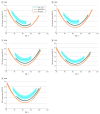Mental Health Trajectories Among US Survivors of Adolescent and Young Adult Cancer as They Age
- PMID: 40388164
- PMCID: PMC12090028
- DOI: 10.1001/jamanetworkopen.2025.11430
Mental Health Trajectories Among US Survivors of Adolescent and Young Adult Cancer as They Age
Abstract
Importance: There are more than 2.1 million adult survivors of cancer diagnosed in adolescence and young adulthood (AYA) in the US. Although the mental health burden during treatment has been well documented, the long-term mental health trajectories of survivors of AYA cancer into later adulthood have not been explored.
Objective: To understand the prevalence and trajectories of mental health challenges among middle-aged or older survivors of AYA cancer compared with those who received a diagnosis as adults or individuals without cancer.
Design, setting, and participants: This cohort study used cross-sectional data from the Health and Retirement Study (HRS) to characterize mental health outcomes for US adults older than 50 years and longitudinal data to examine trajectories of mental health outcomes. The study started on September 1, 2023. HRS is a longitudinal, population-based national sample that interviews approximately 20 000 participants every 2 years since 1992 on topics related to health, employment, income, and others.
Exposure: A diagnosis of cancer during AYA, defined as ages 15 to 39 years.
Main outcomes and measures: The primary outcomes were lifetime prevalence of psychiatric issues, prescription medication for anxiety and/or depression, meeting criteria for Major Depressive Disorder using Composite International Diagnostic Interview-Short Form scoring, depression symptoms using the Center for Epidemiological Studies-Depression measure, and anxiety symptoms using items from the Beck Anxiety Inventory.
Results: A total of 39 668 respondents (22 166 female [55.88%]; mean [SE] age at HRS entry, 59 [0.05] years; age range, 18-103 years; 7699 Black or African American [19.41%]; 28 459 White [71.74%]; 3402 other race [8.58%], which includes American Indian and Asian; and 108 [0.27%] missing) were identified who reported having cancer as an AYA (374 respondents), receiving a first-time cancer diagnosis after study onset as adults (5045 respondents), or never having cancer (34 249 respondents). Cross-sectional estimates revealed survivors of AYA cancer had the highest prevalence of lifetime psychiatric issues (16.36% [95% CI, 7.17%-25.55%] to 37.80% [95% CI, 26.55%-49.06%]), prescription anxiety and/or depression medication (25.10% [95% CI, 17.09%-33.10%] to 33.78% [95% CI, 23.93%-43.64%]), and meeting major depression criteria (13.13% [95% CI, 6.08%-20.18%] to 20.96% [12.91%-29.01%]) versus other cohorts. Compared with adult cancer survivors and even after adjusting for demographic covariates, AYA cancer survivors had higher odds of lifetime psychiatric issues (in 4 of 14 waves), similar odds of taking anxiety or depression medications, and higher odds of meeting major depression criteria (in 3 of 7 waves). Linear mixed-effects growth models revealed age-dependent U-shaped trajectories for depression and anxiety symptoms but significantly higher mean levels of symptoms among AYA cancer survivors. A flattening of anxiety symptoms later in life was only observed for AYA cancer survivors.
Conclusions and relevance: In this cohort study, survivors of AYA cancer reported significantly worse mental health trajectories into middle or older adulthood, compared with individuals who experienced cancer as adults or never had it. Cancer clinicians should recognize the mental health burden for this population into middle age and older adulthood.
Conflict of interest statement
Figures


References
Publication types
MeSH terms
Grants and funding
LinkOut - more resources
Full Text Sources
Medical

